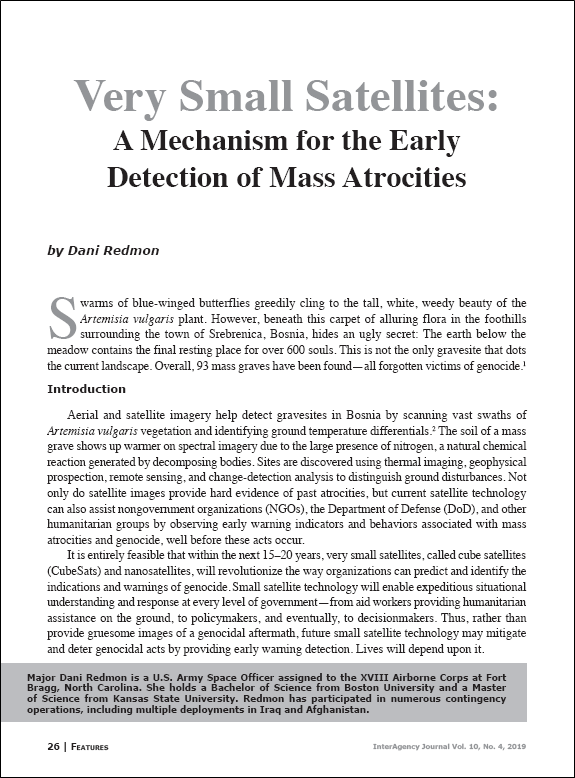Featured Article: A Mechanism for the Early Detection of Mass Atrocities
Featured article:
Very Small Satellites: A Mechanism for the Early Detection of Mass Atrocities
by Dani Redmon
Swarms of blue-winged butterflies greedily cling to the tall, white, weedy beauty of the Artemisia vulgaris plant. However, beneath this carpet of alluring flora in the foothills surrounding the town of Srebrenica, Bosnia, hides an ugly secret: The earth below the meadow contains the final resting place for over 600 souls. This is not the only gravesite that dots the current landscape. Overall, 93 mass graves have been found—all forgotten victims of genocide.
Aerial and satellite imagery help detect gravesites in Bosnia by scanning vast swaths of Artemisia vulgaris vegetation and identifying ground temperature differentials. The soil of a mass grave shows up warmer on spectral imagery due to the large presence of nitrogen, a natural chemical reaction generated by decomposing bodies. Sites are discovered using thermal imaging, geophysical prospection, remote sensing, and change-detection analysis to distinguish ground disturbances. Not only do satellite images provide hard evidence of past atrocities, but current satellite technology can also assist nongovernment organizations (NGOs), the Department of Defense (DoD), and other humanitarian groups by observing early warning indicators and behaviors associated with mass atrocities and genocide, well before these acts occur. It is entirely feasible that within the next 15–20 years, very small satellites, called cube satellites (CubeSats) and nanosatellites, will revolutionize the way organizations can predict and identify the indications and warnings of genocide.Small satellite technology will enable expeditious situational understanding and response at every level of government…
Read the full article
Very Small Satellites: A Mechanism for the Early Detection of Mass Atrocities PDF
Download the complete edition
IAJ 10-4 (2019) pdf
IAJ 10-4 (2019) ePub
Major Dani Redmon is a U.S. Army Space Officer assigned to the XVIII Airborne Corps at Fort Bragg, North Carolina. She holds a Bachelor of Science from Boston University and a Master of Science from Kansas State University. Redmon has participated in numerous contingency operations, including multiple deployments in Iraq and Afghanistan.

READ THE LATEST UPDATES FROM THE SIMONS CENTER
"*" indicates required fields


